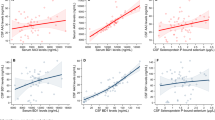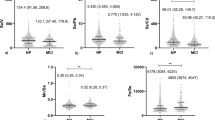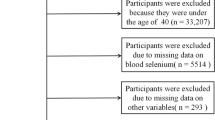Abstract
Background
Studies have established the association between blood β-amyloid (Aβ) levels and Alzheimer’s disease, but population-based studies concerning the association between selenium (Se) and Aβ levels in blood samples are very limited. Therefore, we explored the association in an elderly population with Se status and serum Aβ measures.
Methods
A cross-sectional study on 469 elderly individuals from four rural counties with diverse soil Se levels was carried out. Fasting blood Se, serum selenoprotein P (SELENOP), and glutathione peroxidase (GPX), serum Aβ42, and Aβ40 were measured. Quantile regression models were used to determine the associations of blood Se, serum GPX, and SELENOP with Aβ levels.
Results
Significant negative associations were observed between blood Se and serum Aβ42 and Aβ40 levels at all percentiles (P < 0.05). The associations were generally stronger at higher Aβ42 and Aβ40 percentiles than lower Aβ42 and Aβ40 percentiles. Blood Se was positively associated with serum Aβ42/Aβ40 ratio at 25th, 50th, and 75th percentiles. Significant positive associations were observed between serum GPX and Aβ42 and Aβ40 levels at all percentiles (P < 0.05). The positive associations were generally stronger at higher Aβ42 and Aβ40 percentiles than at lower percentiles. Serum GPX was negatively associated with Aβ42/Aβ40 ratio at 25th, 50th, 75th, and 95th percentiles. No associations with serum SELENOP and Aβ levels were observed.
Conclusions
Our results suggest that higher Se levels are associated with lower serum Aβ42 and Aβ40 levels and with higher Aβ42/Aβ40 ratio, and the results are specific for different selenoproteins.

Similar content being viewed by others
References
Association Alzheimer’s (2019) 2019 Alzheimer’s disease facts and figures. Alzheimer’s & dementia 15(3):321–387
Wang D, Chen F, Han Z, Yin Z, Ge X, Lei P (2021) Relationship between amyloid-beta deposition and blood-brain barrier dysfunction in Alzheimer’s disease. Front Cell Neurosci 15:695479
Benilova I, Karran E, De Strooper B (2012) The toxic Abeta oligomer and Alzheimer’s disease: an emperor in need of clothes. Nat Neurosci 15(3):349–357
Dubois B, Feldman HH, Jacova C, Hampel H, Molinuevo JL, Blennow K et al (2014) Advancing research diagnostic criteria for Alzheimer’s disease: the IWG-2 criteria. Lancet Neurol 13(6):614–629
Nakamura A, Kaneko N, Villemagne VL, Kato T, Doecke J, Dore V et al (2018) High performance plasma amyloid-beta biomarkers for Alzheimer’s disease. Nature 554(7691):249–254
van Oijen M, Hofman A, Soares HD, Koudstaal PJ, Breteler MM (2006) Plasma Abeta(1–40) and Abeta(1–42) and the risk of dementia: a prospective case-cohort study. Lancet Neurol 5(8):655–660
Scharpf M, Schweizer U, Arzberger T, Roggendorf W, Schomburg L, Kohrle J (2007) Neuronal and ependymal expression of selenoprotein P in the human brain. J Neural Transm (Vienna) 114(7):877–884
Toledo JB, Vanderstichele H, Figurski M, Aisen PS, Petersen RC, Weiner MW et al (2011) Factors affecting Abeta plasma levels and their utility as biomarkers in ADNI. Acta Neuropathol 122(4):401–413
Janelidze S, Teunissen CE, Zetterberg H, Allue JA, Sarasa L, Eichenlaub U et al (2021) Head-to-head comparison of 8 plasma amyloid-beta 42/40 assays in Alzheimer disease. JAMA Neurol 78(11):1375–1382
Pillai R, Uyehara-Lock JH, Bellinger FP (2014) Selenium and selenoprotein function in brain disorders. IUBMB Life 66(4):229–239
Chen J, Berry MJ (2003) Selenium and selenoproteins in the brain and brain diseases. J Neurochem 86(1):1–12
Solovyev N, Drobyshev E, Bjorklund G, Dubrovskii Y, Lysiuk R, Rayman MP (2018) Selenium, selenoprotein P, and Alzheimer’s disease: is there a link? Free Radic Biol Med 1(127):124–133
Gwon A-R, Park J-S, Park J-H, Baik S-H, Jeong H-Y, Hyun D-H et al (2010) Selenium attenuates Aβ production and Aβ-induced neuronal death. Neurosci Lett 469(3):391–395
Godoi GL, de Oliveira PL, Schulz JF, Kaufmann FN, da Rocha JB, de Souza DO et al (2013) Selenium compounds prevent amyloid beta-peptide neurotoxicity in rat primary hippocampal neurons. Neurochem Res 38(11):2359–63
Kryukov GV, Castellano S, Novoselov SV, Lobanov AV, Zehtab O, Guigo R et al (2003) Characterization of mammalian selenoproteomes. Science 300(5624):1439–1443
Brigelius-Flohé R (1999) Tissue-specific functions of individual glutathione peroxidases. Free Radical Biol Med 27(9–10):951–965
Crack PJ, Cimdins K, Ali U, Hertzog PJ, Iannello RC (2006) Lack of glutathione peroxidase-1 exacerbates Abeta-mediated neurotoxicity in cortical neurons. J Neural Transm (Vienna) 113(5):645–657
Burk RF, Hill KE, Motley AK (2001) Plasma selenium in specific and non-specific forms. BioFactors 14(1–4):107–114
Bellinger FPHQ, Bellinger MT, Lin Y, Raman AV, White LR, Berry MJ (2008) Association of selenoprotein p with Alzheimer’s pathology in human cortex. J Alzheimers Dis 15(3):465–472
Takemoto ASBM, Bellinger FP (2010) Role of selenoprotein P in Alzheimer’s disease. Ethn Dis 20(Suppl 1):92–95
Dinh QT, Cui Z, Huang J, Tran TAT, Wang D, Yang W et al (2018) Selenium distribution in the Chinese environment and its relationship with human health: a review. Environ Int 112:294–309
Xu W, Tan L, Wang HF, Jiang T, Tan MS, Tan L et al (2015) Meta-analysis of modifiable risk factors for Alzheimer’s disease. J Neurol Neurosurg Psychiatry 86(12):1299–1306
Koenker R, Hallock KF (2001) Quantile regression. J Econ Perspect 15(4):143–156
Staffa SJ, Kohane DS, Zurakowski D (2019) Quantile regression and its applications: a primer for anesthesiologists. Anesth Analg 128(4):820–830
Marco V, Annalisa C, Marcel E, J RK, Tommaso F, Carlotta M, et al (2017) A selenium species in cerebrospinal fluid predicts conversion to Alzheimer’s dementia in persons with mild cognitive impairment. Alzheimer’s Res Ther 9(1):100
Krishnan S, Rani P (2014) Evaluation of selenium, redox status and their association with plasma amyloid/tau in Alzheimer’s disease. Biol Trace Elem Res 158(2):158–165
Li GZ, Liu F, Xu C, Li JY, Xu YJ (2018) Selenium and zinc against Abeta25-35-induced cytotoxicity and Tau phosphorylation in PC12 cells and inhibits gamma-cleavage of APP. Biol Trace Elem Res 184(2):442–449
Fu CXDL, Yuan XY, Xu YJ (2021) Effects of fish oil combined with selenium and zinc on learning and memory impairment in aging mice and amyloid precursor protein processing. Biol Trace Elem Res 199(5):1855–1863
Du X, Wang C, Liu Q (2016) Potential roles of selenium and selenoproteins in the prevention of Alzheimer’s disease. Curr Top Med Chem 16(8):835–848
Deng Z, Fu H, Xiao Y, Zhang B, Sun G, Wei Q et al (2015) Effects of selenium on lead-induced alterations in Abeta production and Bcl-2 family proteins. Environ Toxicol Pharmacol 39(1):221–228
Pankiewicz JE, Diaz JR, Marta-Ariza M, Lizinczyk AM, Franco LA, Sadowski MJ (2020) Peroxiredoxin 6 mediates protective function of astrocytes in Abeta proteostasis. Mol Neurodegener 15(1):50
Schindler SE, Bollinger JG, Ovod V, Mawuenyega KG, Li Y, Gordon BA et al (2019) High-precision plasma β-amyloid 42/40 predicts current and future brain amyloidosis. Neurology 93(17):e1647–e1659
Gao S, Jin Y, Hall KS, Liang C, Unverzagt FW, Ji R et al (2007) Selenium level and cognitive function in rural elderly Chinese. Am J Epidemiol 165(8):955–965
Yan X, Liu K, Sun X, Qin S, Wu M, Qin L et al (2020) A cross-sectional study of blood selenium concentration and cognitive function in elderly Americans: National Health and Nutrition Examination Survey 2011–2014. Ann Hum Biol 47(7–8):610–619
Ran Q, Gu M, Van Remmen H, Strong R, Roberts JL, Richardson A (2006) Glutathione peroxidase 4 protects cortical neurons from oxidative injury and amyloid toxicity. J Neurosci Res 84(1):202–208
Turk HM, Sevinc A, Camci C, Cigli A, Buyukberber S, Savli H et al (2002) Plasma lipid peroxidation products and antioxidant enzyme activities in patients with type 2 diabetes mellitus. Acta Diabetol 39(3):117–122
Iborra M, Moret I, Rausell F, Bastida G, Aguas M, Cerrillo E et al (2011) Role of oxidative stress and antioxidant enzymes in Crohn’s disease. Biochem Soc Trans 39(4):1102–1106
Likidlilid A, Patchanans N, Peerapatdit T, Sriratanasathavorn C (2010) Lipid peroxidation and antioxidant enzyme activities in erythrocytes of type 2 diabetic patients. J Med Assoc Thai 93(6):682–693
Tong Y, Zhou W, Fung V, Christensen MA, Qing H, Sun X et al (2005) Oxidative stress potentiates BACE1 gene expression and Abeta generation. J Neural Transm (Vienna) 112(3):455–469
McCarty MF, DiNicolantonio JJ, Lerner A (2021) A fundamental role for oxidants and intracellular calcium signals in Alzheimer’s pathogenesis-and how a comprehensive antioxidant strategy may aid prevention of this disorder. Int J Mol Sci 22(4):2140
Marrocco I, Altieri F, Peluso I (2017) Measurement and clinical significance of biomarkers of oxidative stress in humans. Oxid Med Cell Longev 2017:6501046
Saeedi M, Rashidy-Pour A (2021) Association between chronic stress and Alzheimer’s disease: therapeutic effects of Saffron. Biomed Pharmacother 133:110995
Jang JK, Park KJ, Lee JH, Ko KY, Kang S, Kim IY (2017) Selenoprotein S is required for clearance of C99 through endoplasmic reticulum-associated degradation. Biochem Biophys Res Commun 486(2):444–450
Yim SY, Chae KR, Shim SB, Hong JT, Park JY, Lee CY et al (2009) ERK activation induced by selenium treatment significantly downregulates beta/gamma-secretase activity and Tau phosphorylation in the transgenic rat overexpressing human selenoprotein M. Int J Mol Med 24(1):91–96
Solovyev N (2020) Selenoprotein P and its potential role in Alzheimer’s disease. Hormones (Athens) 19(1):73–79
Yue C, Shan Z, Tan Y, Yao C, Liu Y, Liu Q et al (2020) His-rich domain of selenoprotein P ameliorates neuropathology and cognitive deficits by regulating TrkB pathway and zinc homeostasis in an Alzheimer model of mice. ACS Chem Neurosci 11(24):4098–4110
Van der Jeugd A, Parra-Damas A, Baeta-Corral R, Soto-Faguas CM, Ahmed T, LaFerla FM et al (2018) Reversal of memory and neuropsychiatric symptoms and reduced tau pathology by selenium in 3xTg-AD mice. Sci Rep 8(1):6431
Funding
This work was supported by grants from the National Key Research and Development Program of China (2018YFC801102), the National Institutes of Health of USA (R01AG019181), and the Key Laboratory of Trace Element and Nutrition, National Health Commission of China (WLKFZ202201).
Author information
Authors and Affiliations
Contributions
Jiao Luo: data curation; software; formal analysis; writing—original draft; Liqin Su: conceptualization, funding acquisition, project administration, writing—review and editing; Xiaohong He: investigation, data curation, resources; Yegang Du: methodology, data curation, resources; Ning Xu: investigation, supervision; Rangpeng Wu: investigation, data curation; Yunfeng Zhu: investigation, data curation; Ting Wang: data curation, validation; Ranqi Shao: data curation, software; Frederick W. Unverzagt: resources, supervision; Ann M. Hake: resources, supervision; Yinlong Jin: resources, funding acquisition, supervision; Sujuan Gao: resources, funding acquisition, supervision.
Corresponding author
Ethics declarations
Conflict of Interest
The authors declare no competing interests.
Additional information
Publisher's Note
Springer Nature remains neutral with regard to jurisdictional claims in published maps and institutional affiliations.
Rights and permissions
Springer Nature or its licensor (e.g. a society or other partner) holds exclusive rights to this article under a publishing agreement with the author(s) or other rightsholder(s); author self-archiving of the accepted manuscript version of this article is solely governed by the terms of such publishing agreement and applicable law.
About this article
Cite this article
Luo, J., Su, L., He, X. et al. Blood Selenium and Serum Glutathione Peroxidase Levels Were Associated with Serum β-Amyloid in Older Adults. Biol Trace Elem Res 201, 3679–3687 (2023). https://doi.org/10.1007/s12011-022-03480-4
Received:
Accepted:
Published:
Issue Date:
DOI: https://doi.org/10.1007/s12011-022-03480-4




